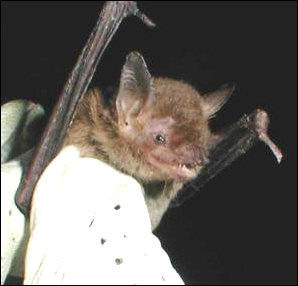


Myotis velifer. U.S. National Park Service photograph.
This species lives in a variety of habitats, but generally is a colonial, cave-dwelling bat. Other roosting areas are in rock crevices, old buildings, carports, under bridges, and even in abandoned Cliff Swallow nests. The Cave Myotis is the most abundant bat of the Edwards Plateau, and it hibernates in central Texas caves in the winter; often it may also hibernate in the Panhandle region in gypsum caves in the area (Davis and Schmidly 1994). The bats usually roost in clusters that may number into the thousands, with nursery colonies reaching as large a group as 15,000 or more (Tuttle 2003). Other species occasionally found with the Cave Myotis include the big-eared bats (Plecotus), free-tailed bats (Tadarida), big brown bats (Eptesicus), Yuma Myotis (Myotis yumanensis), and ghost-faced bats (Mormoops). While these bats may share a roosting site with the Cave Myotis, the different species most often will segregate, with different bats inhabiting distinctly separate areas of the site (Davis and Schmidly 1994). This bat is very widely distributed throughout the Trans-Pecos, having been observed in every county except El Paso (Schmidly 1977).
Davis, W. B., and D. J. Schmidly. 1994. The mammals of Texas. Texas Parks and Wildlife Press, Austin.
Schmidly, D. J. 1977. The mammals of Trans-Pecos Texas including Big Bend National Park and Guadalupe Mountains National Park. Texas A&M University Press, College Station.
Tuttle, M. D. (2003). Texas bats. Bat Conservation International, Inc., Austin.
A. Ruth Huckaby, Graduate Student, BIOL 5301—Natural History of the Chihuahuan Desert, June, 2006.
Huckaby Update: 22 June 2006
Update: 24 Jul 2009